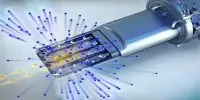Cambridge University researchers have demonstrated that a computer processor can function on an astonishing new form of battery. Researchers placed blue-green algae in a container with electrodes the size of an AA battery, and the microorganisms were able to use sunlight to generate enough electricity to operate the computer for six months. The cyanobacteria allowed the computer to run in 45-minute cycles of working and 15-minute standby, according to Energy & Environmental Science.
It wasn’t solving difficult equations, though; instead, it was computing the sum of successive integer values (to mimic a computational burden), monitoring the battery’s current output, and transmitting the information to the cloud. The battery has continued to provide electricity since the trial finished in August 2021. “We were amazed by how consistently the system operated over such a long period of time – we expected it to stop after a few weeks, but it just kept going,” said Dr. Paolo Bombelli of the University of Cambridge’s Department of Biochemistry in a statement.
The system used 0.3 microwatts of electricity during computation time and 0.24 microwatts during idle time throughout the course of six months. However, it is unclear how it accomplishes this. The most plausible reason, according to the researchers, is that cyanobacteria (blue-green algae) emit electrons during photosynthesis. However, the absence of light had no effect on the power. The electricity was consistent throughout the day and night. This might be due to the algae processing part of its food in the absence of light, resulting in the generation of an electrical current.
These algae-powered batteries may not be able to power a house just yet (scalability is being researched), but they can surely power tiny gadgets, especially in isolated regions. They are cheap and may be combined with small electronics in different appliances and sensors since they are created from inexpensive and recyclable materials. It might be a game-changer for the so-called “Internet of Things,” which envisions real items (the “things”) equipped with sensors, software, and other technologies being able to communicate with any device through the Internet one day. One of the present constraints is the scarcity of lithium; there isn’t enough of it being created.
However, the availability of a bio-battery like this might be a game-changer in bringing it to fruition. “The developing Internet of Things will require an increasing amount of power, and we believe that this will have to come from systems that can create energy rather than merely store it like batteries,” said Professor Christopher Howe, one of the paper’s joint senior authors. “Because it’s always using light as an energy source, our photosynthetic technology doesn’t run out like a battery.”
















